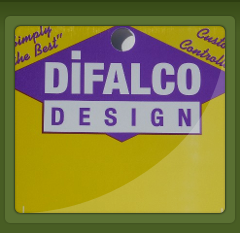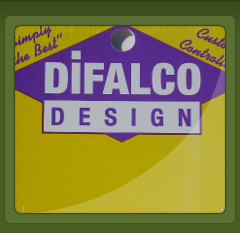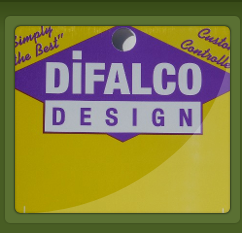DIFALCO DESIGN
"SIMPLY THE BEST"




|
TECHNICAL TALK
CONTROLLER FEATURES AND GLOSSARY
ACU-PIVOT TRIGGER PIN: Custom threaded trigger pivot on all Difalco Design controllers has an adjusting nut to keep side play in trigger bushings to a minimum as oilites wear. BALL BEARING TRIGGER: All Difalco controllers come standard with ball bearing triggers. Ball bearings remove all trigger pivot side play for the life of the controller. This helps maintain excellent and reliable wiper button pressure with minimum tension and less friction for a lighter trigger spring tension. BRAKE RHEOSTAT, ECONOMY: Low cost rheostat with a wide resistance range. Rheostat looks identical to sensitivity rheostat. 1/24 scale: 5 ohms, 1/32: 25 ohms, H.O.: 100 ohms BRAKE RHEOSTAT, PRO: Heavy duty 3 ohm rheostat takes more abuse from incorrect hookups. It will give slightly better full brake response than economy rheostat when used on controllers without our E.S.P. feature. Has full off position to shut off brake response for wing cars when needed. BRAKING: Reducing the amount of brakes your car has helps keep car speed up and smoothes out your driving on most tracks for higher lap totals. A must for all scales. CHOKE (1/24 SCALE): Used in Group 7 and Eurosport racing to limit power to motors on high powered tracks. Difalco Design chokes have a rotary selector and a relay bypass push-button for passing. Contact Jim for custom choke controllers or to upgrade your current controller. CHOKE (H.O., 1/32): Used on faster motors to limit track power. Lower power makes cars easier to drive consistently on tight courses for higher lap totals. Our choke is electronic and uses the main power transistor to reduce track power controlled by a rheostat. COAST (H.O. SCALE): Used in H.O. scale to keep small amount of power flowing to car when trigger is released. This small amount of power applied to the car helps keep car speed at a minimum and smoothes out driving for faster laps. Our coast is electronic and is controlled by a rheostat to adjust power. Used mainly on higher powered cars. DIODE: Protects transistor outputs from damage in case of incorrect hookup or hookup to wrong polarity track. (Small black cylindrical device with silver band) The silver band lead connects to the heatsink (positive) side of the controller. E.S.P. Extreme Stopping Power Brake Relay: Our Genesis HD30 controllers feature a thin multi-conductor cable with our innovative E.S.P. (Extreme Stopping Power) brake relay. The relay is located on the heatsink/transistor assembly just 1’ from the hook-up studs for reduced brake circuit resistance. The relay is activated by a tiny slide switch on the main circuit board and bypasses both the brake rheostat and the brake fuse for the lowest resistance possible. The E.S.P. has diode protection to prevent it from turning on in case of incorrect hook up. The E.S.P. relay is activated by the wiper board even before the trigger reaches the normal brake post. This turns on the relay earlier for better braking response. E.S.P. BYPASS SWITCH: Our DD228-15 push-button switch can be added to activate the E.S.P. relay for one tight turn, then released to resume reduced braking in other turns for faster lap times. FANATIC FEATURE: Small blue pot on each wiper band adjusts individual band resistance. This feature sets our controllers apart from everyone else’s! Turn pots to change controller’s power curve, speed up or slow down entire sensitivity range to suit your driving style, track layout or car type. FANATIC POT ADJUSTMENTS: 1/24 racers must adjust all blue Fanatic pots to halfway as a starting point!!! This range will be a good starting point to run a typical 16d motor. The Fanatic pots allow this controller to run anything from 1/32 to a G7 motor. The faster the motor the more sensitive the Fanatic pots range needs to be. You should adjust the Fanatic pots so when the main sensitivity knob is set to zero the car gets just enough power to move. FANATIC POT ADJUSTMENT TIPS: Do not be afraid to adjust the Fanatic pots! Pots are labeled from #1 (first band) to #15 on rear of circuit board. (The last two bands are fixed bands without any adjustments) Pots are factory set to the slowest “notch” embossed on the pots face which is good for 1/32 cars. Pots pointer has an arrow that shows pointer direction. Turn pot with screwdriver clockwise to increase that bands sensitivity or counter clockwise to reduce sensitivity (direction is marked on rear of circuit board). The Fanatic pots control the overall resistance for our transistor circuit. The Fanatic pots are in series and have a value of 20 ohms each for a total of 300 ohms when they are all set to slow. (Band #16 has a fixed resistance of 10 ohms for a total of 310 ohms) Each notch on the face of the blue pot is 2 ohms. Adjusting pot #10 will slow that bands response as well as slowing all the pots that are before it (#1 to #9). It is best to get the overall resistance in the correct range first by turning all the pots to the same position. Then you can fine tune the power curve to your liking after that. FANATIC POTS 1/24 motors: a good starting point for Falcon and 16d type motors is 150 ohms (all pots halfway), but can range from 130 to about 180 ohms total. G12 motors need about 100 ohms to 150 ohms total resistance. G15 motors need about 80 to 120 ohms. G27 and G7 ohms need about 50 to 70 ohms. From the total resistance needed you can figure out how much resistance you need for each of the 15 bands. FANATIC POTS 1/32 motors: while the factory setting of 310 ohms may work for your situation I recommend turning all the pot clockwise one notch (2 ohms each for a total of 280 ohms) to start. From there you can increase or decrease the sensitivity as needed. FIBERGLASS FRAME: Our exclusive computer routed frame is extremely accurate, has a simple layout and keeps wiring neat. Our thicker 3/32" frame will not flex in your hand like ordinary controllers with 1/16" circuit boards. The frame is also screwed to rear controller handle for easy maintenance and rigidity. FLOATING WIPER BUTTON: Our wiper button floats unconnected in our specially bent wiper arm to automatically lay flat across the entire contact surface. This keeps button from jumping to different bands regardless of side pressure on trigger while driving. NOTE: We recommend you keep your stock rounded button when installing a Genesis module since electronic controllers do not suffer from wiper arcing like resistor or diode types. If you want to set up a floating button on your module conversion buy a Parma wiper button. I do not recommend silver buttons. FUSE, “E”LECTRONIC RESET: Fuse will blow and disconnect brake or power circuit on direct shorts. Once hook up is corrected the reset fuse automatically starts working again! No need to replace, ever! Fuse is a tan square with two leads that may be on the rear of our frame or between the heatsink and circuit board on out transistor assembly. HOOK UP: Transistor controllers are sensitive to the two different types of track polarities in use today. If you do not know your tracks polarity hook up the black and white clips only (not red) of your controller to the lane. Without pulling trigger touch cars braid to track with wheels in air. If car does not get power then you are on correct polarity track. Hook up red clip and race. If car gets power then you are on the wrong polarity track. See dual or negative polarity paragraph to switch controller for correct operation. DO NOT SWITCH ALLIGATOR CLIPS AT THE TRACK POSTS! HOOK UP, 2 OR 3 WIRE OPERATION: Some 1/32 and H.O. tracks only have hook up studs for the black and white alligator clips. Unlike other brands our transistor circuit is not affected by 2 wire operation. Almost any Difalco controller can be used on 2 wire tracks. All "E"motion controllers can run on 2 wire tracks. Certain Genesis controllers that only use a relay for full power must use a brake hook up or the car will not get full power. Generally any Difalco controller that uses a circuit board mounted to our heatsink with a relay must be used on 3 wire operation. HOOK UP TIPS: Diode on heat sink protects transistor by sending power to lane if you hook up to wrong polarity track or reverse black and white clips by accident. If car takes off at full speed without touching trigger, unhook controller immediately to avoid car damage. Get in the habit of hooking up controller before you put car on track. Keep transistor heat sink and circuit board away from track terminals! Lay controller on panel and hook up controller with two hands to avoid sparking clips on wrong posts. No controller is protected against every different hookup. Taking your time and following these simple tips will greatly reduce any chance of controller problems. MUSH BUTTON: Used to momentarily slow controller sensitivity. Used mainly in Group 27 and Group 7 racing on sticky tracks to reduce popping after de-slotting and track calls. NETWORK: All HD 30 band controllers come with a network circuit board that plugs into our main circuit board. This network board contains the resistance needed for our transistor circuit. Changing the network resistance to a different value will let our controllers run anything from 1/32 to the fastest 1/24 G7 motor. NICKEL PLATING: All our circuit boards are plated to eliminate corrosion on wiper contacts common on copper designs. PLUG AND PLAY: Some controllers have wiper band resistors that plug into electronic sockets allowing you to slow down, speed up or alter the way the power comes on as you pull the trigger across the wiper bands. Just plug in a different value resistor to tune your controller for your motor or driving style. Resistors are available from Difalco Design. POLARITY, DUAL: Dual polarity controllers will function on both positive and negative wired tracks. Controllers are set at the factory to positive polarity. POLARITY, NEGATIVE: Most of our controllers can be switched to negative polarity operation. Older "E"motion controllers use a plug system or you can swap the position of the transistor wires where they solder to the main wires. Never switch positions of the alligator clips at the hookup panel to run on the opposite polarity type track! POLARITY, POSITIVE: Standard as shipped from factory. Some controllers are only positive polarity while others are dual polarity that can be changed with our terminal, plug or switch design. Never switch positions of the alligator clips at the hookup panel to run on the opposite polarity type track! POLARITY, TRACK: Positive polarity (gate) means an ohmmeter shows a “+” (power terminal is positive) when measured between the tracks power terminal and the brake terminal (red ohmmeter probe on power terminal). Negative polarity (gate) will show a “-” (power terminal is negative) when measured this way. The large majority of tracks today (80% - 90%) are positive polarity. POWER CONTACT: Some controllers feature a large triple silver plated power contact. Unlike all other designs our contact floats so it can automatically align with the trigger contact. Having more surface contact means our controllers can get more track power to your car! RELAY, “BLAST” FULL POWER: Relay is mounted 8” from alligator clips and when activated allows full power to go through relay over a shorter resistance path. On non relay controllers track power has to travel from white clip up to handle, through higher resistance contacts and wire then back down to black clip. Genesis controllers use a heavy duty 40 amp relay with 10 ga. wires to make sure all track power is delivered to your car. Beware of other manufacturers that use 12 ga wire with thick insulation! SENSITIVITY RHEOSTAT: Varies how much power the transistor puts out over the wiper bands. The faster the motor the more power needed to drive it. This rheostat controls the overall sensitivity and is separate from the individual resistors on the wiper bands which control the basic sensitivity range for your type motor. Rotate knob to find best sensitivity setting for your track and car type. TRANSISTOR: Electronic device to control flow of power to car. This is the diamond shaped silver or flat square black device mounted in heat sink. The main advantages of electronic controllers are that there is no high power on the wiper contacts like resistor or diode controllers, this eliminates arcing and reduces maintenance. The other advantage is you can control a wide range of motors with the same controller. VOLTAGE: Electronic controllers are affected by the track voltage being used.The higher the track voltage the more sensitive a controller will be and the lower the track voltage the less sensitive a controller will feel at the same sensitivity knob setting. WIPER BANDS: The individual bands on circuit board used to vary power to the car. WIRE, 10 GAUGE: Most Difalco Design controllers use heavy 10 gauge wire to reduce power loss to your car. Don’t be fooled by clear 12 gauge stereo wire that looks heavy duty.
|